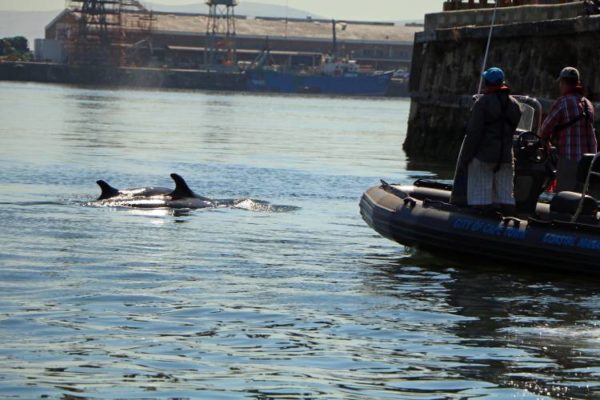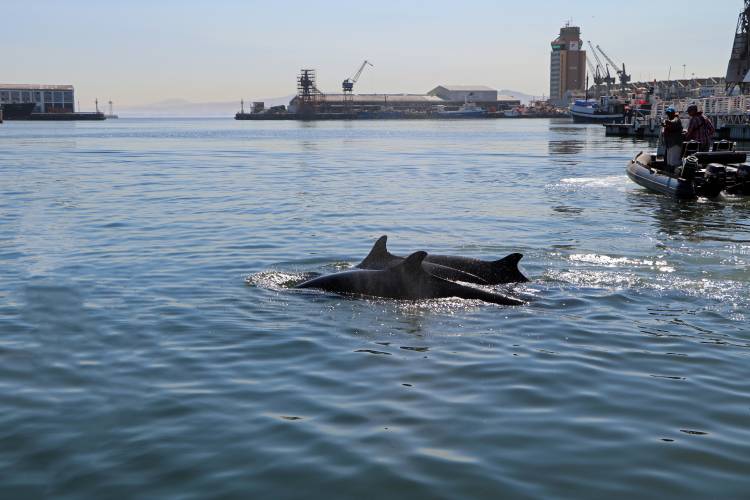On Monday, four false killer whales spotted in the harbour at the V&A Waterfront appeared to be lost. Two Oceans Aquarium said in a post on their website that the pod, recently spotted in the harbour, appear to be the same ones who were beached days before. A video of locals trying to help the beached mammals back into the water has surfaced.
NSRI spokesman Craig Lambinon yesterday said that the pod included a calf and were reportedly swimming inside the Port of Table Bay in the V&A Marina. He warned sailors and curious onlookers not to get too close to them.
Two Oceans Aquarium updated information on their blog site saying: On 4 February, a pod of four false killer whales were spotted in the waters of the V&A Waterfront. One appears to be an injured adult and at least one other is a young calf. It is believed that these are the same false killer whales that were beached and subsequently rescued at Sunset Beach, Milnerton. At this stage the location and health of the pod was monitored and it was hoped that they would leave the harbour by themselves.

Yesterday morning, 5 February, it was decided that action needed to be taken to shepherd the false killer whales out of the harbour. They appeared healthy, but there was concern that they would be unable to navigate out of the harbour due to the noise (dolphins rely on echolocation to navigate) and that they would starve.
Three boats were dispatched, staffed by the Aquarium, DEA and CoCT, to carry out manoeuvres to drive the false killer whales from the inner harbour, the V&A Waterfront’s Alfred Basin, either out of the harbour completely or into an area with less boat activity.
Together, the loud engines of the boats were used to shepherd the false killer whales into the Victoria Basin, no small task as we needed to be careful to avoid boat strikes – either knocking them with our own boats or driving them in front of other ship traffic. Eventually, the pod was coralled to the harbour mouth, but at this stage it seemed unwilling to venture back into Table Bay.
#falsekillerwhale spotted in the @VandAWaterfront whilst on @AWOLTours #cape town #city #cycletour. Two oceans aquarium staff are keeping an eye on the pod and suspect one has a head injury and they taking refuge in the waterfront whilst it’s wounds heal pic.twitter.com/0lXKDvRxqZ
— AWOL Tours (@AWOLTours) February 5, 2018
It was decided that the false killer whales were growing used to the sounds of our boat engines, and had learned that they could dive under them instead of swimming away. Instead of continuing to attempt to drive them out of the harbour, we shepherded them into the much quieter South Arm of the harbour. It is hoped that from here, they will make a direct exit from the harbour when it is quieter.
We will continue to monitor the area and provide ongoing updates. If you come across a beached mammal, you should contact one of the following organisations to dispatch an appropriate response:
-
- Two Oceans Aquarium – 021 418 3823
- DEA – 083 462 5345
- City of Cape Town – 083 940 8143
- NSRI – 082 380 3800
And a video to see their efforts. ❤ pic.twitter.com/1O4IQ0lItO
— Leanne Kruger (@krugerleanne) February 4, 2018
What are False Killer Whales: False killer whales (Pseudorca crassidens) are a rare dolphin species, widely distributed in tropical and subtropical deep oceans. They seldom enter shallow coastal waters, and their ongoing presence in the waters of Cape Town is quite unusual (although not unprecedented). Their bodies are slender and they are usually a dark grey or black, giving them the name “blackfish” in some countries. Sometimes they have pale grey or white markings on the sides of their faces and on their chests. They do not have beaks like bottlenose dolphins, the species that most people associate with “dolphins”, but their upper jaws form smooth domes, known as “melons”.
Pictures: Two Oceans Aquarium






